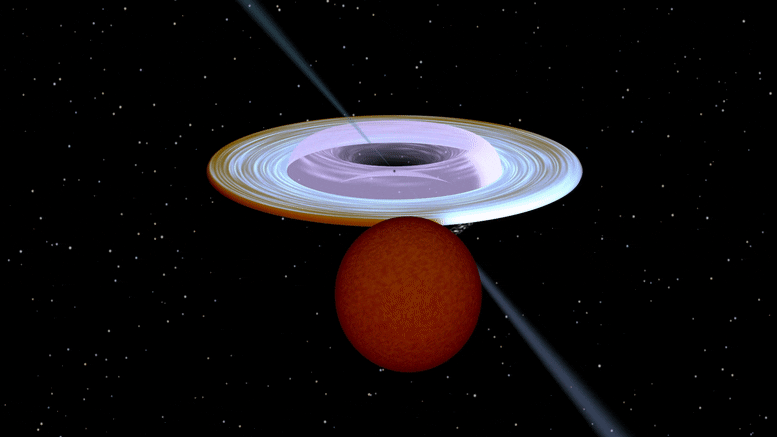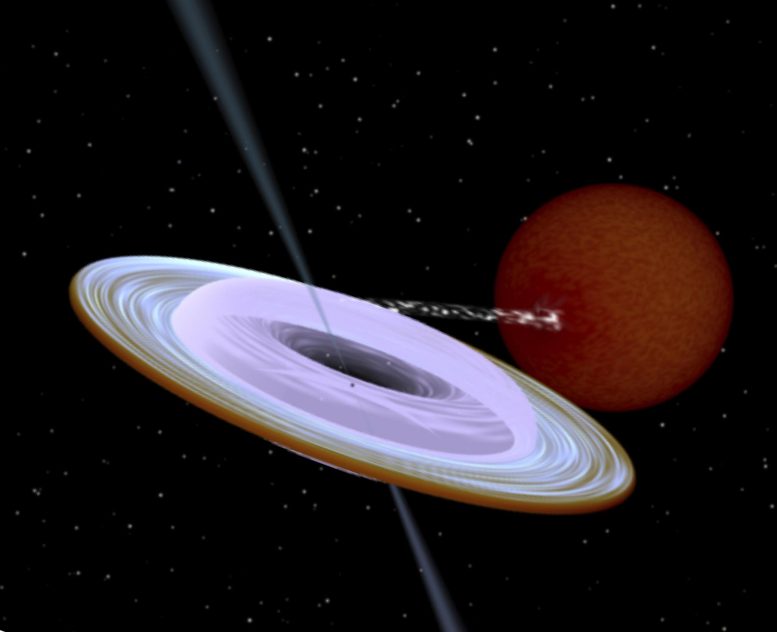
Artist impression of the X-ray binary system MAXI J1820+070 containing a black hole (small black dot at the center of the gaseous disk) and a companion star. A narrow jet is directed along the black hole spin axis, which is strongly misaligned from the rotation axis of the orbit. Image produced with Binsim. Credit: R. Hynes
New Finding in Astronomy: Black Hole Spins on Its Side
Scientist Prof. Dr. Svetlana Berdyugina, Professor of Astrophysics at the University of Freiburg and Director of the Leibniz Institute for Solar Physics (KIS), together with an international team of astronomers, has reliably measured for the first time a large difference between the rotation axis of the black hole and the axis of the orbit of the binary star system named MAXI J1820+070. The black hole’s rotation axis is tilted by more than 40 degrees with respect to the axis of the star’s orbit. “This finding challenges current theoretical models of black hole formation,” Berdyugina says. The team published their findings in the journal Science.
Astronomers previously assumed a small angle
“The difference of more than 40 degrees between the orbital axis and the spin of the black hole was completely unexpected. Scientists have often assumed that this difference is very small when modeling the behavior of matter in a curved period around a black hole,” Berdyugina explains. The new finding forces astronomers to add a new dimension to their models.

Artist impression of the X-ray binary system MAXI J1820+070 containing a black hole (small black dot at the center of the gaseous disk) and a companion star (red). A narrow jet is directed along the black hole spin axis, which is strongly misaligned from the axis of the orbit. Image produced with Binsim. Credit: R. Hynes
Polarization opens new path to understanding black holes
The research team made its discovery with the astronomical polarimeter DIPol-UF, an instrument for measuring the angle of the optical rotation of light. It was built by the Leibniz Institute for Solar Physics (KIS) and the University of Turku/Finland. It was finally put to use in the Nordic Optical Telescope on La Palma, Spain. “Our polarimeter used, DIPol-UF, is unique in its ability to measure optical polarization with the precision and accuracy of a few parts per million. Determining the orbital orientation of black holes based on polarization opens a new path to understanding their formation and physics,” Berdyugina explains.
Astronomers observed jets in the radio- and X-ray range
The black holes in binary star systems were formed by a cosmic cataclysm – the collapse of a massive star. Now, the researchers noted how a black hole drags matter from the nearby, lighter companion star orbiting the system’s gravitational center. Bright optical radiation and X-rays as the last sigh of infalling material were seen, as well as radio emission from the jets ejected from the system. By tracking the luminous gas streams, the jets, in the radio and X-ray range, the scientists were able to pinpoint the direction of the black hole’s rotation axis.
In addition to Svetlana Berdyugina, the research project involved researchers from the University of Turku/Finland, the Space Research Institute of the Russian Academy of Sciences/Russia, the University of Stockholm/Sweden, Liverpool John Moores University/England, Radboud University/Netherlands, the Netherlands Institute for Space Research/Netherlands, the University of Denver/USA and the Universidad de La Laguna/Spain.
For more on this discovery, see Death Spiral: A Black Hole Spins on Its Side.
Reference: “Black hole spin–orbit misalignment in the x-ray binary MAXI J1820+070” by Juri Poutanen, Alexandra Veledina, Andrei V. Berdyugin, Svetlana V. Berdyugina, Helen Jermak, Peter G. Jonker, Jari J. E. Kajava, Ilia A. Kosenkov, Vadim Kravtsov, Vilppu Piirola, Manisha Shrestha, Manuel A. Perez Torres and Sergey S. Tsygankov, 24 February 2022, Science.
DOI: 10.1126/science.abl4679









Be the first to comment on "Astronomers Discover Unexpected Incline of a Black Hole"